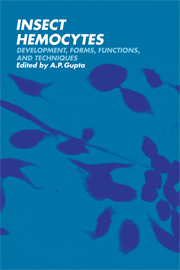Book contents
- Frontmatter
- Contents
- Preface
- List of contributors
- Part I Development and differentiation
- Part II Forms and structure
- 4 Hemocyte types: their structures, synonymies, interrelationships, and taxonomic significance
- 5 Surface and internal ultrastructure of hemocytes of some insects
- 6 Fine structure of hemocyte membranes and intercellular junctions formed during hemocyte encapsulation
- 7 Controversies about the coagulocyte
- 8 Controversies about hemocyte types in insects
- 9 Hemocyte cultures and insect hemocytology
- 10 Pathways and pitfalls in the classification and study of insect hemocytes
- Part III Functions
- Part IV Techniques
- Indexes
9 - Hemocyte cultures and insect hemocytology
Published online by Cambridge University Press: 04 August 2010
- Frontmatter
- Contents
- Preface
- List of contributors
- Part I Development and differentiation
- Part II Forms and structure
- 4 Hemocyte types: their structures, synonymies, interrelationships, and taxonomic significance
- 5 Surface and internal ultrastructure of hemocytes of some insects
- 6 Fine structure of hemocyte membranes and intercellular junctions formed during hemocyte encapsulation
- 7 Controversies about the coagulocyte
- 8 Controversies about hemocyte types in insects
- 9 Hemocyte cultures and insect hemocytology
- 10 Pathways and pitfalls in the classification and study of insect hemocytes
- Part III Functions
- Part IV Techniques
- Indexes
Summary
Introduction
The importance of insect tissue and cell cultures has long been recognized by entomologists because cells, tissues, and organs grown in vitro in controlled physical environment and nutrient media provide ideal systems for studying insect pathology, developmental biology, hemocytology, physiology, and cell biology.
Insect hemocyte cultures are of much value in the study of the origin and differentiation of hemocyte types. They can help elucidate the origin and function of the hemopoietic organs in insects and the interrelationships among various hemocytes, and their use could settle the controversies about insect hemocyte types.
Unfortunately, however, in vitro cultivation of insect tissues and cells has been very difficult (Vaughn, 1968; Brooks and Kurtti, 1971; Feir and Pantle, 1971). Although the first known attempt to grow insect tissue cultures was made in 1915 (Goldschmidt, 1915), it was not until almost 50 years later that the first continuous insect cell line was obtained by Grace (1962). Culturing insect hemocytes in vitro has been even more difficult than culturing other insect tissues (Arnold, 1974; Mazzone, 1976). But considerable progress has been made in recent years in growing insect tissue cultures. Over 100 continuous lines of insect cells, including six of hemocytes, have been developed since 1962 (Hink, 1976).
Although six continuous cell lines of insect hemocytes have been obtained, it is not always possible to start a successful primary culture of hemocytes at will, let alone develop a new continuous cell line. In recent years insect tissue culture has been reviewed by Brooks and Kurtti (1971), Hink (1972), Stanley (1972), and Granados (1976).
- Type
- Chapter
- Information
- Insect HemocytesDevelopment, Forms, Functions and Techniques, pp. 259 - 278Publisher: Cambridge University PressPrint publication year: 1979
- 2
- Cited by



